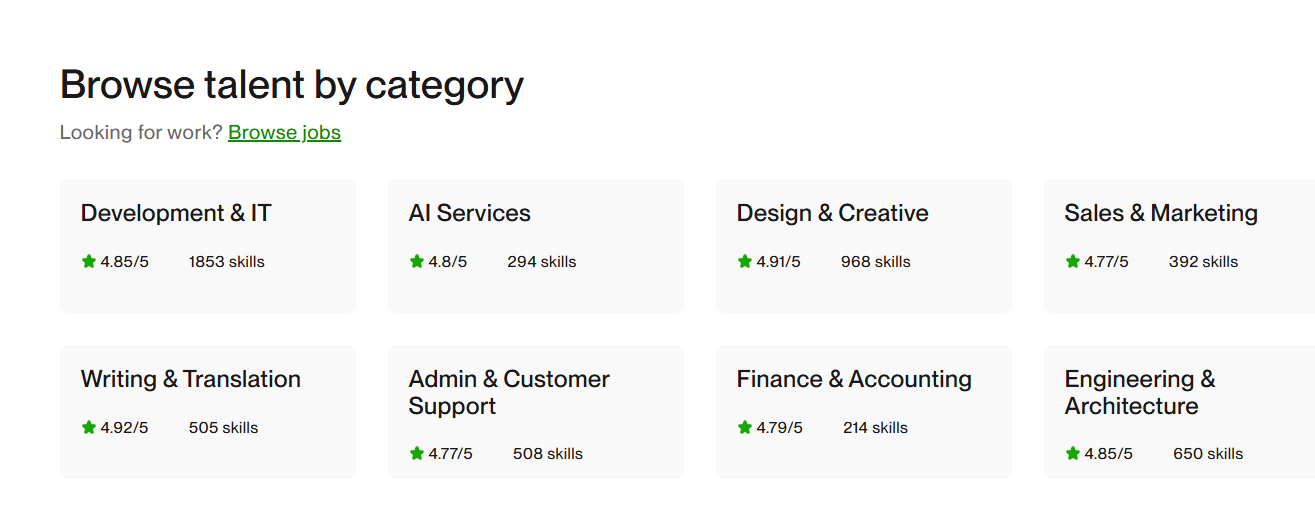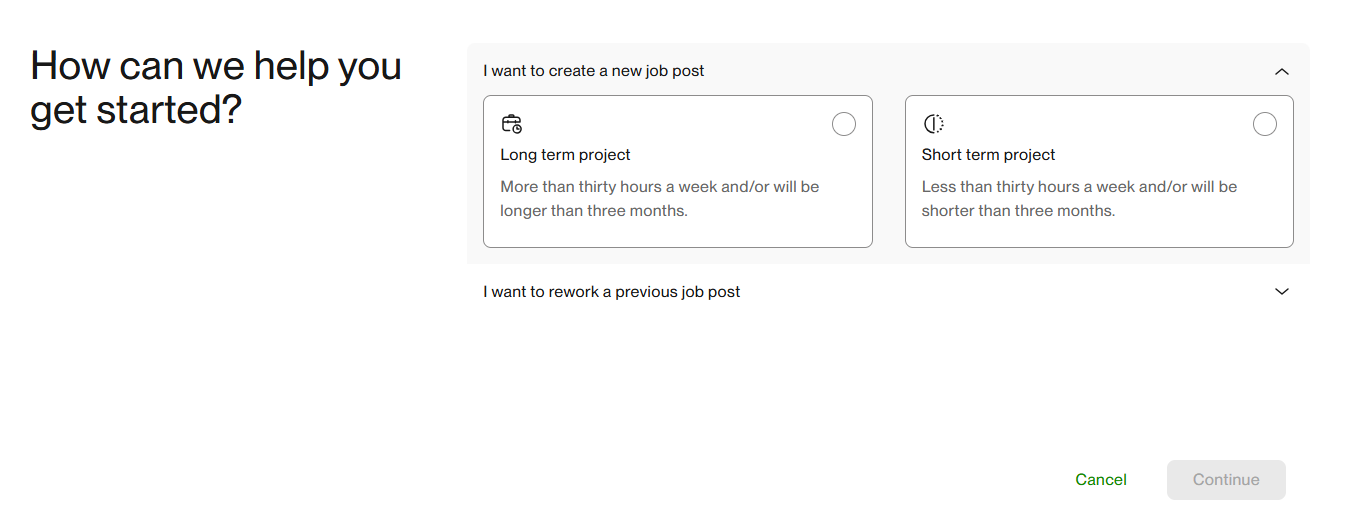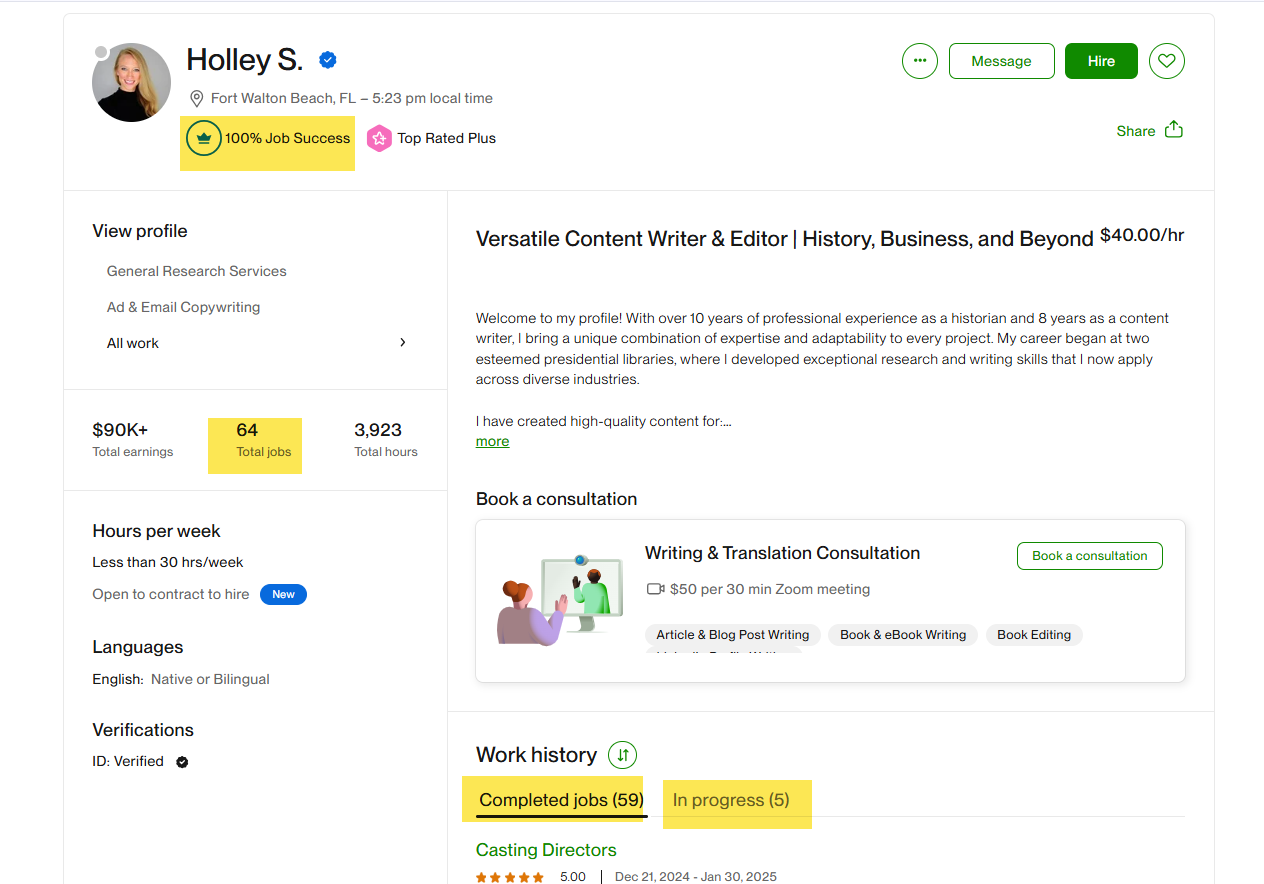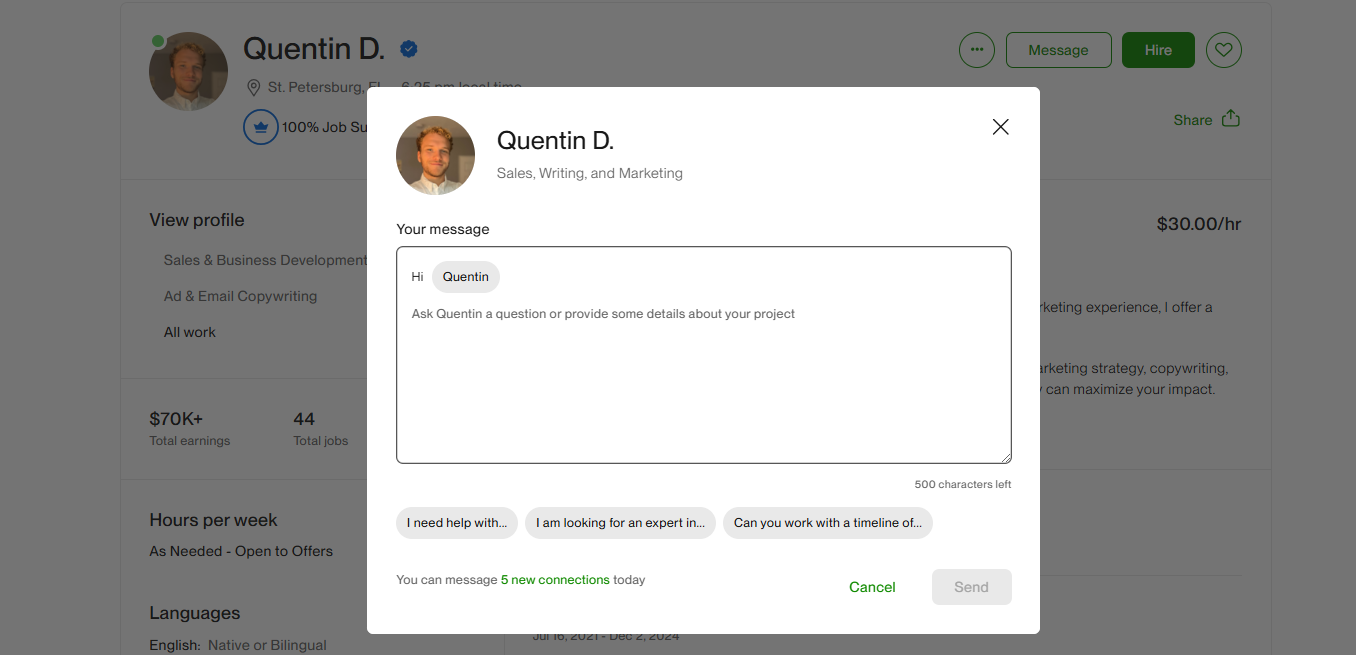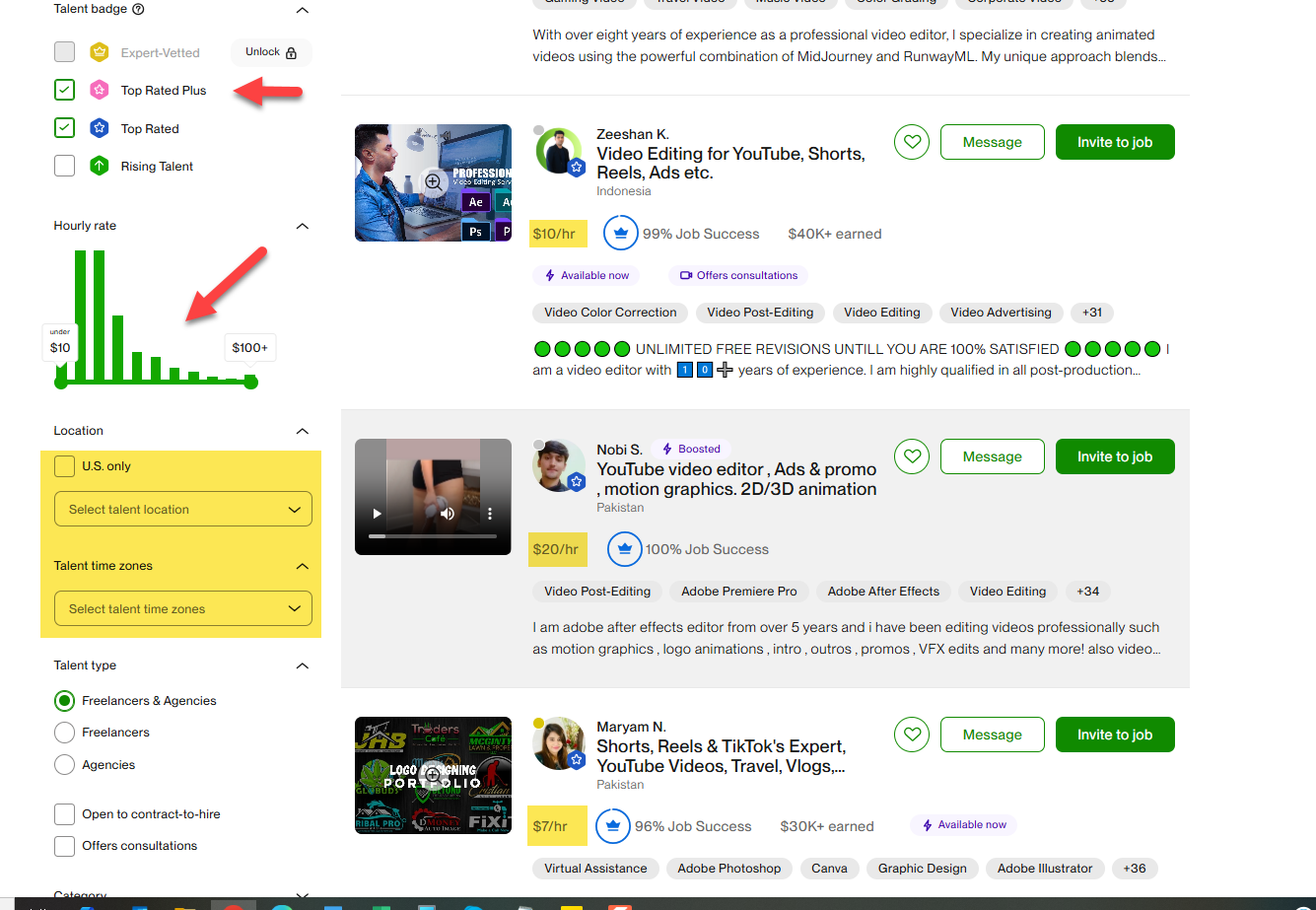Imagine this… you’re knee-deep in your latest project, deadlines looming, and you realize that an extra pair of hands isn’t just a luxury, it’s a necessity. We’ve all been there. The world of freelancing offers a myriad of solutions but knowing where to start can feel like navigating a maze without a map.
That’s where Upwork comes into play. Having been entrenched in the outsourcing scene for over 14 years, I’ve seen platforms evolve and shift. While my main go-to is no longer Upwork, I still pop over from time to time to see what’s available when I need help. It’s a massive marketplace, filled with freelancers to meet your every need.
Interestingly, one standout feature nowadays is the option to take freelancers off the platform for direct hiring, a complete game-changer since it used to be forbidden territory. This is just one of the ways Upwork is evolving to meet the needs of overworked business owners who need help.
Throughout this post, I’ll guide you through using Upwork efficiently and effectively. Let’s explore how you can shake up your business operations with just a few clicks.
Understanding Upwork’s Ecosystem
Upwork functions like a bustling online marketplace where talent meets demand. It’s a bit like a digital bazaar, where freelancers of all stripes: writers, designers, developers are all ready to tackle your projects. But how does it all work? Well, think of Upwork as the middleman who introduces clients and freelancers, ensuring both sides are equipped with the tools they need for success.
The freelancer-client dynamic on Upwork is all about collaboration and communication. You post a job, freelancers submit proposals, and you sift through them to find the right match… kind of like swiping right, but for business partnerships. However, it’s not just about waiting for proposals to roll in. It’s equally important to take a proactive approach by inviting freelancers to your job posting. Think of it as fishing—you throw out your net, but you also want to use a line to catch the best fish individually.
The benefits of using Upwork are many. It offers a vast pool of global talent at your fingertips, flexible pricing options to suit your budget, and built-in tools for project management. All these make it an attractive choice for those seeking quality work without the hassle of traditional hiring.
Creating an Effective Job Post
Crafting a job post on Upwork isn’t just about tossing out a list of tasks and hoping for the best. It’s an art form. A clear and detailed job description is crucial, it sets the tone for your project and helps attract the right freelancers. Think of it like creating a blueprint; the more precise you are, the more likely you are to find someone who can build exactly what you envision.
Start by defining the scope of your project. What exactly do you need? Break down your requirements into manageable pieces. This helps freelancers understand what’s expected and ensures you’re on the same page from the get-go. Be explicit about deliverables and deadlines, but remain open to a freelancer’s input, after all, they might just surprise you with insights you hadn’t considered.
And let’s talk about keywords… they’re not just for SEO! Use specific terms that relate to your industry or project needs. If you’re seeking a graphic designer, terms like “branding,” “logo design,” or “Adobe Illustrator” are must-haves. These keywords ensure that your job post surfaces in relevant searches, attracting freelancers who have the skills you require.
Now that nearly all platforms have integrated AI, it’s easier than ever to post a job that will get attention.
By investing time upfront to create a solid job post, you’re setting the stage for a successful partnership. After all, it’s not just about finding any freelancer, it’s about finding the right freelancer for your project.
Evaluating Freelancer Profiles
When you’re on Upwork, perusing freelancer profiles is akin to flipping through résumés… only without the paper cuts. But what should you actually look for? Key elements such as a freelancer’s work history, skills, and portfolio are the starting points. A well-crafted profile will often include detailed descriptions of past projects, showcasing the freelancer’s expertise and style.
Reviews and feedback are goldmines of information. Instead of skimming them, dive into specifics. Look for patterns in feedback—consistent praise or repeated concerns can reveal a lot about work ethic and reliability. Don’t be deterred by a single negative review; even the best freelancers encounter a difficult client now and then. Instead, weigh the overall consensus to gauge credibility.
Ratings are another piece of the puzzle. While a high rating can be reassuring, it’s important to understand its implications. A five-star rating is impressive, but consider the volume and recency of reviews. A freelancer with fifty reviews at 4.8 stars might offer more assurance than someone with just two glowing five-star ratings.
The number of jobs completed provides insight into their experience level. It’s also wise to check their current workload. If they’re juggling 14 other projects, they might not have the bandwidth to focus on yours as intensely as needed. Sometimes, it’s better to save them for another time when their plate isn’t quite as full.
Ultimately, evaluating profiles is about building a comprehensive picture of potential collaborators. Take your time… sift through the details, because your business deserves nothing but the best fit for your needs.
Conducting Interviews and Assessments
When conducting interviews on Upwork, your goal is to uncover the true potential behind that polished profile. Crafting insightful questions is key. Instead of sticking to the basics, ask questions that dig deeper, like “Can you describe a challenging project you’ve worked on and how you overcame obstacles?” This approach gives you a glimpse into their problem-solving skills and adaptability.
It’s also wise to inquire if they have experience in your specific industry. While not a deal-breaker, a “yes” can mean they’ll understand your nuances better. Discuss any limitations on revisions upfront, knowing this can prevent future frustrations. Clarifying their true availability and a realistic timeframe for project completion is essential to ensure your deadlines align with their schedule.
Test projects or trial periods are invaluable, offering a sneak peek into what the freelancer brings to the table. They showcase capabilities, work ethic, and commitment, acting as a low-risk strategy that saves headaches later.
Setting clear expectations from the start is crucial. Outline project goals, timelines, and communication preferences upfront. This clarity helps establish a strong working relationship and ensures both parties are aligned… reducing misunderstandings and paving the way for successful collaboration.
Negotiating Terms and Pricing
Negotiating terms on Upwork is where the scope of work takes center stage. Clearly defining the scope upfront prevents misunderstandings and ensures everyone is on the same page. Freelancers often list hourly rates on their profiles, but I’m a fan of project-based payments. Hourly rates can balloon past your budget, whereas fixed costs provide financial clarity from the start.
Keep in mind the category and location of the freelancers as that can affect their rates. You can also use the filters, including budget to narrow down the result to get a better match before you reach out.
Take responsibility for sticking to the agreed scope. It’s tempting to add requests mid-project but remember… these aren’t freebies. If you realize post-agreement that you forgot something—like software integration with a new website—expect to pay extra. Similarly, changing your mind on an approved design and wanting something different warrants additional compensation.
Think of how you’d feel if a client kept shifting goalposts without acknowledging the extra effort required. Discuss the number of revisions allowed at the outset; this can’t be emphasized enough. It’s a mutual respect thing… ensuring both you and your freelancer have a clear, fair path forward.
Managing the Freelance Relationship
Managing your freelance relationship on Upwork hinges on regular and effective communication. Frequent check-ins keep both parties aligned, ensuring no detail slips through the cracks. Utilize Upwork’s tools to monitor progress—these can be invaluable for tracking milestones and deliverables.
When conflicts arise, address them promptly to ensure quality work. Determine if delays stem from your added requests or missed deadlines on their end. Understanding the cause helps in finding a fair resolution. If the situation deteriorates, consider canceling the job. Should disagreements persist, Upwork support can mediate, though working through issues amicably is preferable.
When things do go smoothly, celebrate your success! You’ll have a reliable freelancer ready for future projects… a true asset in your business arsenal.
Moving Forward
Hiring through Upwork offers numerous benefits, from access to global talent to flexible project management. Embrace the power of freelancers to fuel your business growth. If you’re uncertain about finding top freelancers on Upwork, don’t hesitate, book a call today for valuable insights and guidance on maximizing your investment.


